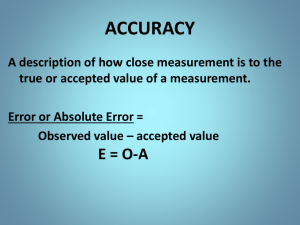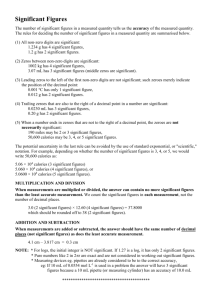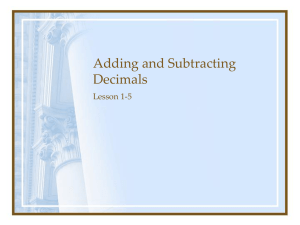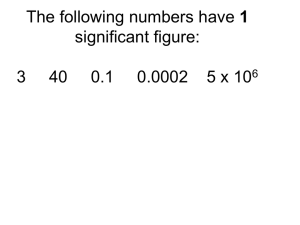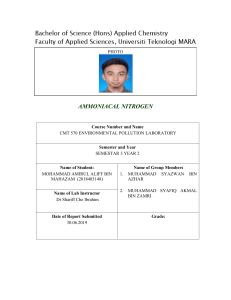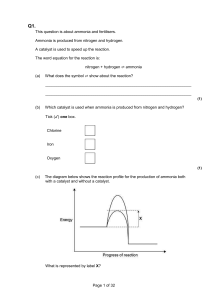Significant figures are critical when reporting scientific data because they
advertisement
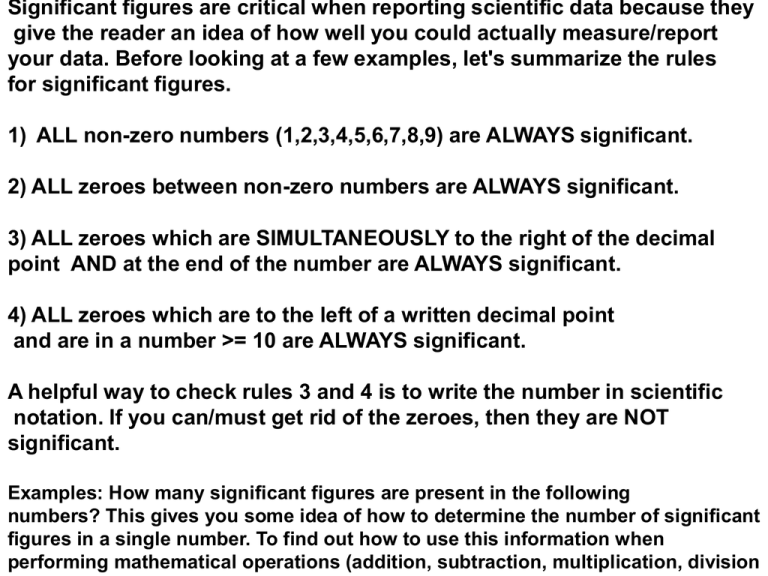
Significant figures are critical when reporting scientific data because they give the reader an idea of how well you could actually measure/report your data. Before looking at a few examples, let's summarize the rules for significant figures. 1) ALL non-zero numbers (1,2,3,4,5,6,7,8,9) are ALWAYS significant. 2) ALL zeroes between non-zero numbers are ALWAYS significant. 3) ALL zeroes which are SIMULTANEOUSLY to the right of the decimal point AND at the end of the number are ALWAYS significant. 4) ALL zeroes which are to the left of a written decimal point and are in a number >= 10 are ALWAYS significant. A helpful way to check rules 3 and 4 is to write the number in scientific notation. If you can/must get rid of the zeroes, then they are NOT significant. Examples: How many significant figures are present in the following numbers? This gives you some idea of how to determine the number of significant figures in a single number. To find out how to use this information when performing mathematical operations (addition, subtraction, multiplication, division Number # Significant Figures Rule(s) 48,923 5 1 3.967 4 1 900.06 5 1,2,4 0.0004 (= 4 E-4) 1 1,4 8.1000 5 1,3 501.040 6 1,2,3,4 3,000,000 (= 3 E+6) 1 1 10.0 (= 1.00 E+1) 3 1,3,4 FOR THE REACTION BELOW ∆H = -1367 C2H5OH (g) + 3 O2(g) 2 CO2(g)+ 3H2O(g) + 1367 kJ 1) WHAT IS THE NAME AND FAMILY OF THE ORGANIC REACTANT? 2) CALCULATE THE HEAT RELEASED PER MOLE OF OXYGEN IN THIS REACTION.? 3) WHAT IS THE MOLE RATIO OF OXYGEN TO CARBON DIOXIDE.? 4) IF 7 MOLES OF OXYGEN REACT, HOW MANY MOLES OF ETHANOL AND OF CARBON DIOXIDE ARE RELEASED. 5) CALCULATE THE MOLAR MASS AND PERCENT COMPOSITION OF ETHANOL. 6) WHAT TYPE OF REACTION IS THIS. 7) DRAW A POTENTIAL ENERGY GRAPH FOR THIS REACTION. FOR THE REACTION BELOW ∆H = +91.8 kJ, its final conditions are STP. 91.8 kJ + 2NH3 (g) N2(g) + 3 H2(g) 1) WHAT TYPE OF REACTION IS THIS? 2) DRAW A POTENTIAL ENERGY DIAGRAM FOR THIS REACTION. 3) RENDER THE LEWIS DOT STRUCTURE OF AMMONIA. 4) WHAT TYPE OF ATTRACTIONS ARE PRESENT IN AMMONIA? 5) COMPARE THE RELATIVE MELTING AND BOILING POINTS OF HYDROGEN AND NITROGEN? 6) IF 4 L OF AMMONIA REACT, HOW MANY LITERS OF NITROGEN ARE PRODUCED. 7) IN TERMS OF BOND ENERGY, WHY IS THIS REACTION ENDOTHERMIC? 8) DEFINE ENTROPY, HOW DOES IT CHANGE IN THIS REACTION.? FOR THE REACTION BELOW ∆H = +91.8 kJ 91.8 kJ + 2NH3 (g) N2(g) + 3 H2(g) 1) IF PRESSURE IS REDUCED, HOW WOULD THE REACTION CHANGE? 2) IF THE TEMP IS INCREASED, HOW WOULD THE REACTION CHANGE? 3) IF THE TEMPERATURE IS DECREASED, WHICH SUBSTANCES WOULD INCREASE AND WHICH WOULD DECREASE? 4) IF MORE N2 WAS ADDED, HOW WOULD THE OTHER SUBSTANCES CHANGE. 5) IF AMMONIA WAS REMOVED, HOW WOULD HYDROGEN AND NOTROGEN CHANGE. 6) HOW WOULD A CATALYST CHANGE THE EQUILIBRIUM?
